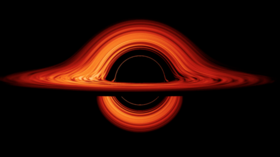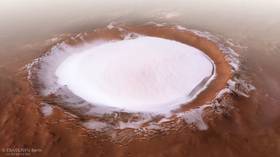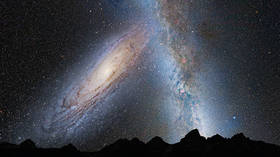‘Impossible black hole’ discovery in Milky Way may have been just that, as scientists spot major errors in research

A recent theory about an “impossibly” large black hole roughly 70 times the mass of the Sun, and rumored to be residing in our own Milky Way, appears to have been debunked, as three separate papers claim it really is impossible.
The central thesis in all three papers, coincidentally published around the same time, is that the light interpreted as coming from this behemoth black hole may have come from an entirely different source.
Also on rt.com Planetary systems ‘of astonishing scale’ could exist on doorstep of supermassive black holesIn the original paper, astronomers led by Jifeng Liu of the National Astronomical Observatory of China, claimed the existence of LB-1, a black hole located 15,000 light-years away with a mass 70 times that of the Sun, something previously believed (and now most likely confirmed) to be impossible.
The stars which could potentially form a black hole of that mass typically die in an extremely violent kind of supernova which guarantees that such large black holes do not form. If it existed, LB-1 would have upended our understanding of black holes and the wider universe.
So, how did Liu and his team make such a gargantuan error?
It turns out the ‘radial velocity’ technique Liu and his fellow researchers employed to measure ‘wobbling’ light emanating from the black hole’s accretion disk (superheated debris from objects it has destroyed) had some major flaws.
The black hole Liu and his team studied is locked in an orbit with its binary star partner. Normally, the radial velocity technique is used to determine the mass of objects orbiting each other by measuring how much they move (wobble) relative to each other.
What Liu and his team interpreted as light being emitted from the black hole was actually
light being absorbed by the star (or rather, its superheated gas). Once the companion star’s dark ‘absorption line’ was removed from observations of the “impossibly” massive black hole, it suddenly stopped wobbling, leading the potential debunkers to conclude that the black hole is actually no more than 20 solar masses.
Threeseparateteams from the University of California, Berkeley (Radial velocity technique error), the University of Auckland in New Zealand (multiple simulations of black hole binary systems at 15,000 light years distance) and KU Leuven in Belgium (similar to UC Berkeley technique but with more up-to-date data from the HERMES spectrograph) all came to the same conclusion at roughly the same time, using a variety of different analyses but all essentially debunking the impossible black hole theory.
Also on rt.com Runaway Star ejected from Milky Way’s ‘Heart Of Darkness’ at 6 MILLION kmph (VIDEO)While none of the three papers has undergone peer review, they all arrived at the same conclusion using different methodologies, with is fairly damning in and of itself, if not 100 percent conclusive… yet.
Like this story? Share it with a friend!













